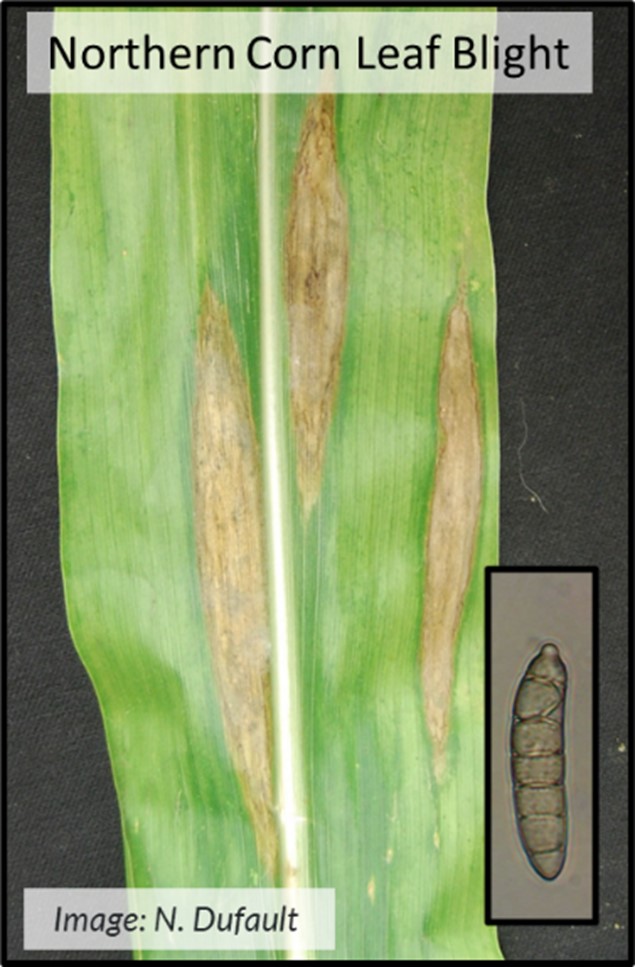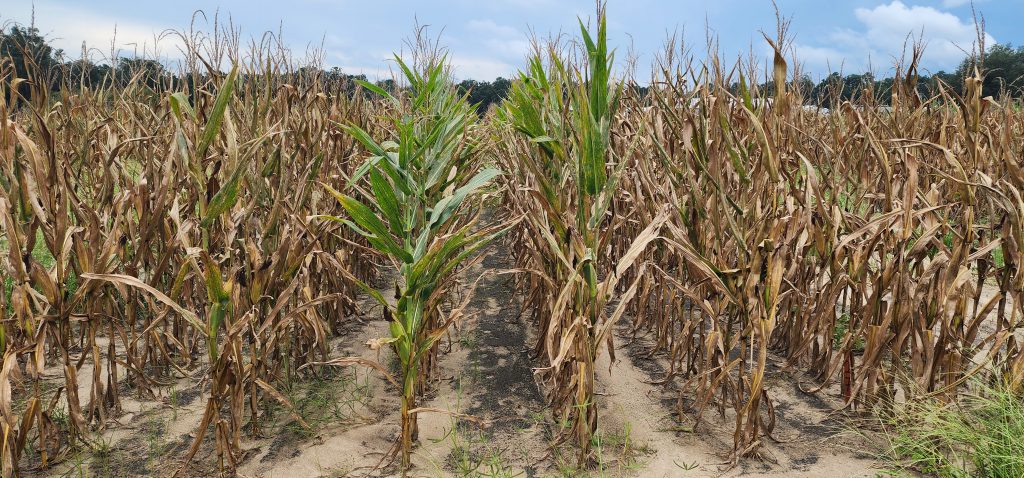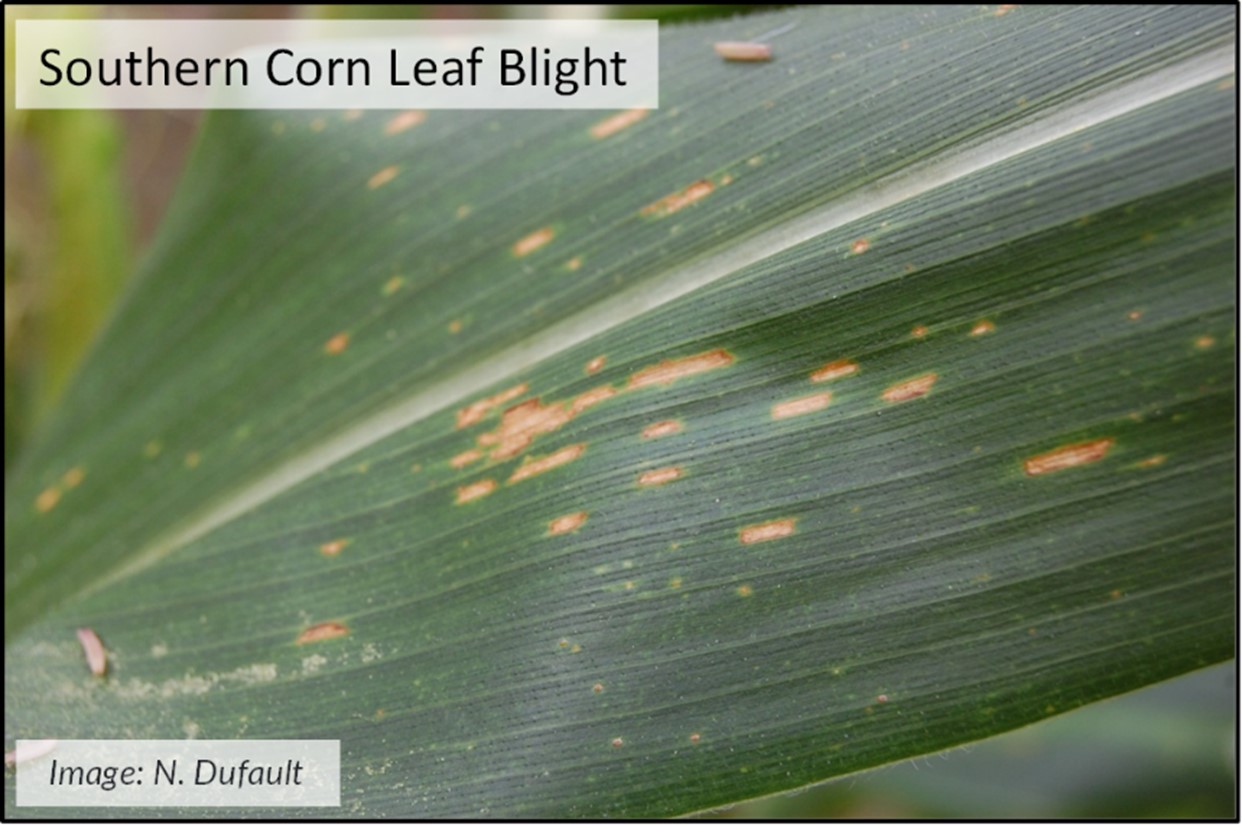
Figure 1: Northern corn leaf blight symptoms. Image in lower right is an example of the pathogen’s spores.
Blights, spots and rusts; oh my! It is getting to that time of year when we start to see diseases showing up in corn and begin to wonder if we should spray a fungicide or not. Southern rust is an explosive and damaging corn disease in which fungicide applications can save yields especially in irrigated corn or when we have a wet season (current El Niño forecast indicates higher precipitation in May and June). However, when it comes to leaf blights, they are not as explosive as rust but can be damaging in the right situations.
–
1st Identify the Disease
Determining the right situation for fungicide management of leaf blight starts with diagnosing which one is present. Typically, northern corn leaf blight (NCLB) has large, cigar shaped lesions that can turn gray with age (Figure 1), while southern corn leaf blight (SCLB) has smaller, tan lesions with reddish brown margins (Figure 2). It can be difficult to separate SCLB lesions from other foliar pathogens (e.g. corn leaf spots), however, laboratory identification of spores can confirm the presence of this disease.
–
Assess the Risk
Both leaf blight diseases can cause severe damage to a corn crop, however, NCLB is typically seen as the more worrisome disease as it can cause greater yield losses than SCLB. The development and spread of these diseases are favored by high humidity and/or wet (e.g. heavy rainfall) environments when temperatures are relatively cool (64° F to 84° F). The pathogens of these diseases are known to survive by overwintering in corn crop residue. Thus, planting corn behind corn, as well as conservation tillage practices can provide the pathogens with plant tissue to develop inoculum early in the season.
So, how do you determine the right situation to spray a fungicide? There can be a high risk for leaf blight diseases when:
- Disease is present. Low levels of disease, such as less than 5% severity below the ear leaf, is not a high-risk level with leaf blights, but scouting and monitoring is important to stay ahead of the disease.
- A susceptible variety is present. Resistant traits to SCLB and NCLB can be found in corn varieties, so if these diseases are a problem and you would like to lower your risk, it is critical to plant a resistant variety.
- Environmental conditions are cool and wet. If we have a susceptible host, disease presence and an optimal disease environment then the crop is at high risk for leaf blight diseases.
Other factors that increase disease risk are:
- Crop rotation is corn followed by corn. This can create high levels of inoculum locally in a field.
- Conservation or minimum tillage is used. This can leave crop residue in the field that allows the pathogens to develop before the corn crop is above the soil line.
–
Fungicides are Not Always Necessary
While leaf blights can be devastating to corn production, we do not always need a fungicide application to manage them. This is especially true if a resistant variety has been planted, as the risk of these diseases developing and spreading will be greatly inhibited. Continuous field scouting with risk assessments are critical to determining when to spray. If blights are a problem, sprays as early as the 5-th leaf stage may be necessary and economically beneficial. However, sprays around tasseling are the most critical to consider as this is when sprays for southern rust should be considered too. In many situations, if a fungicide is applied at 5-th or 6-th leaf stage then a second spray around silking may also be efficacious for blights.
If a fungicide is needed, there are many products available for SCLB and NCLB management. Choosing the right product depends on the risk of disease, disease presence and the expected yield of the crop. If questions arise in making this decision, contact your local Extension Office for more information.
- 2025 End-of-Season Florida Peanut Disease Notes - October 24, 2025
- Southern Rust Confirmed in the Florida Panhandle – June 2025 - June 6, 2025
- Stay Ahead of Disease with the Spore Report: A New Tool to Assist with Potato and Watermelon Management - April 11, 2025


